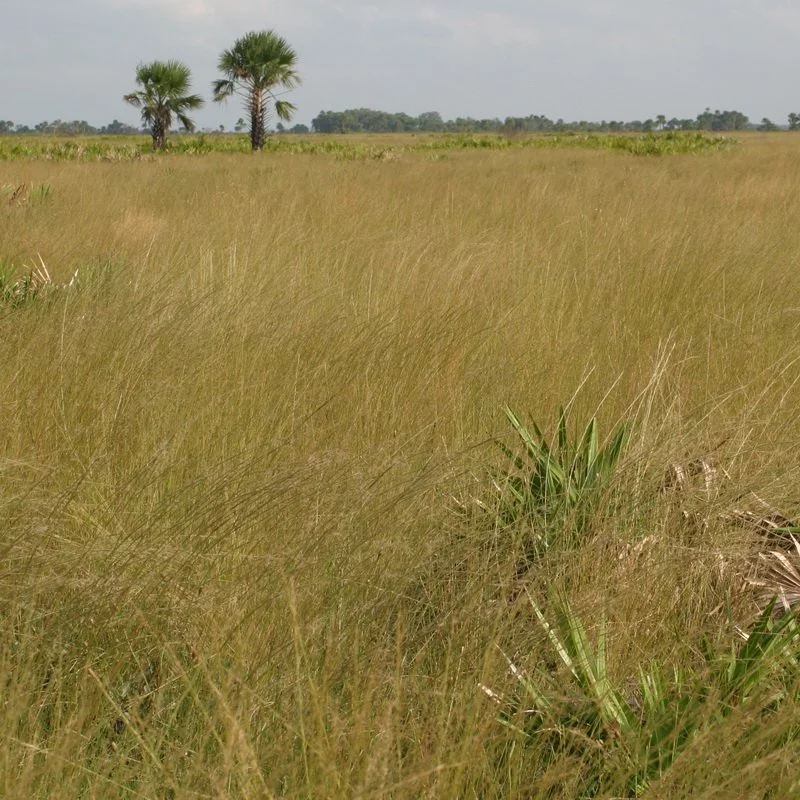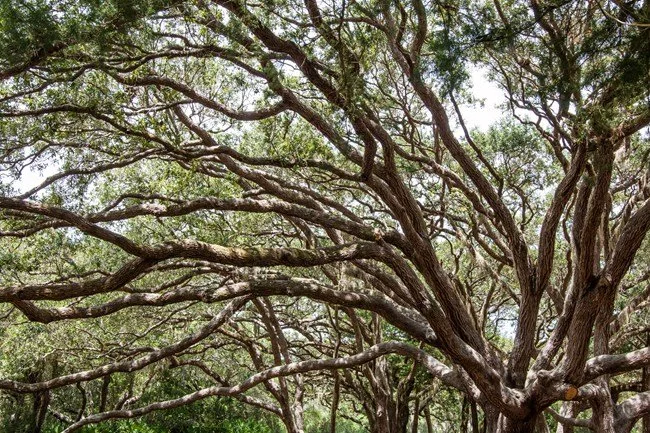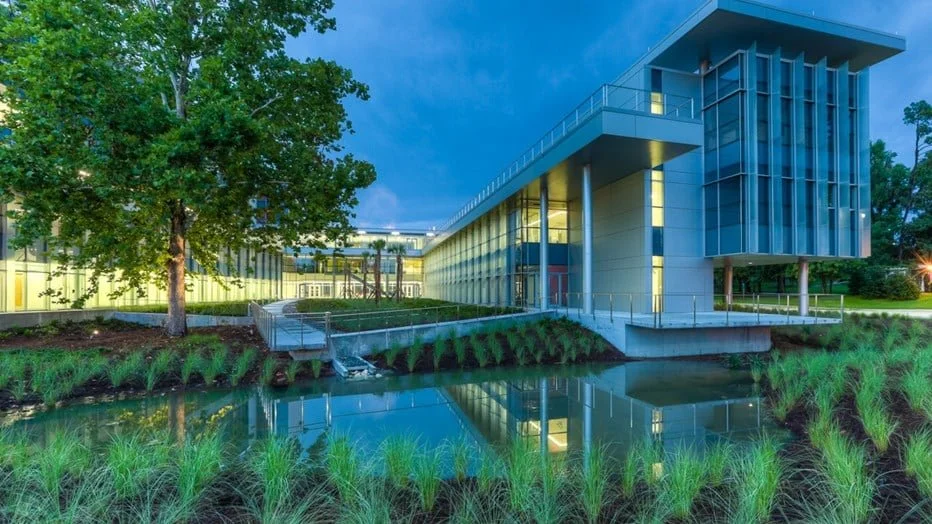Rooted Systems: Designing with Florida’s Native Plants in Mind
When we talk about sustainable design, it’s tempting to stop at the visual: green roofs, leafy courtyards, and lush pathways. But real sustainability runs much deeper. It’s about designing with intention, measuring impact, and choosing strategies that give back more than they take. Florida’s native plants are one of the most overlooked yet powerful tools in environmental design.
These aren’t just pretty landscapes. They are living systems; natural infrastructure that manages stormwater, stabilizes soil, sequesters carbon, and restores balance to ecosystems. When integrated thoughtfully, native plants elevate projects beyond aesthetics into resilient, regenerative design.
Stormwater Management: Nature’s Own Infrastructure
Florida’s heavy rains, flooding, and runoff challenges make stormwater a critical design concern. Conventional stormwater systems, such as concrete drains or retention ponds, often require extensive resources and can disrupt local ecosystems. Native plants offer a smarter, ecologically integrated approach.
Species such as Muhly Grass (Muhlenbergia capillaris) form dense networks of deep roots that increase soil infiltration, slow runoff, and reduce erosion. Controlled studies show native grasses can reduce soil loss by up to 80% compared to traditional turfgrass. Wetland species like Pickerelweed and Duck Potato act as natural filters, cleaning nutrients and pollutants from water before it leaves the site, preventing downstream environmental damage. Beyond ecological benefits, vegetated systems lower the need for costly drainage infrastructure, reducing construction and long-term maintenance expenses while still meeting Florida’s stringent water management standards. With thoughtful design, stormwater becomes an asset rather than a liability.
Soil Stabilization: Building Resilience from the Ground Up
Florida’s sandy soils present a unique challenge; they are prone to erosion, low in organic matter, and easily compacted. Native plants are uniquely adapted to thrive in these conditions, and in doing so, they strengthen the land itself. Key strategies include:
Cabbage Palm (Sabal palmetto) anchors soil with an extensive root system, preventing washouts along slopes and coastal edges.
Saw Palmetto and Wiregrass form dense mats that lock sandy soil in place, reducing the need for artificial erosion control measures.
Restored longleaf pine ecosystems rebuild soil health over time, supporting biodiversity while adding stability across large tracts of land.
Healthy soil becomes a living foundation, ensuring the longevity and resilience of developments built upon it.
Carbon Sequestration: Quiet Climate Action
Carbon reduction often feels abstract, but native plants make it tangible. A single mature Cabbage Palm can sequester approximately 30 pounds of carbon dioxide per year, while Southern Live Oaks, with their expansive canopies and dense wood, store thousands of pounds over their lifetimes. At scale, entire native ecosystems, including pine flatwoods, wet prairies, and coastal habitats act as carbon sinks, actively removing emissions from the atmosphere while sustaining wildlife. By thoughtfully incorporating native species into projects, designers can move beyond carbon-neutral rhetoric to create spaces that materially contribute to climate mitigation.
Advancing Environmental Health: Design Beyond Green
Native planting offers measurable ecological benefits beyond appearance:
Air Quality: Native trees filter pollutants and help reduce the urban heat island effect.
Biodiversity: Florida natives sustain pollinators, migratory birds, and keystone species that non-natives cannot support.
Water Quality: Designed wetlands planted with natives reduce nitrogen and phosphorus levels in stormwater, creating a measurable defense against harmful algal blooms.
Pest Management: Native systems attract beneficial insects and birds that help regulate pests naturally, limiting the need for pesticides and reducing chemical runoff.
In short, native planting enhances environmental health in ways that are both visible and measurable.
Long-Term Maintenance: Cost and Care That Work With Nature
One of the most overlooked benefits of native planting is its efficiency in long-term maintenance. Once established, native plants largely rely on rainfall rather than irrigation. They are adapted to local soils and pests, meaning minimal fertilizer or chemical inputs are required. Dense native plantings act as living groundcover, reducing labor-intensive mowing, pruning, and replacement cycles. Over time, these factors can lower annual maintenance costs by 30–60%, demonstrating that environmentally responsible design can also be economically smart.
Florida Case Studies: Natives in Action
Across Florida, projects are putting native plants to work at scale. Naples Botanical Garden integrates nearly 90 acres of native habitats that act as stormwater filters, biodiversity refuges, and carbon sinks, while also serving as engaging public attractions. Lake Nona in Orlando leveraged native plantings in parks and streetscapes to reduce irrigation needs by more than 40%, creating thriving pollinator networks in the process. Vizcaya Museum & Gardens in Miami incorporates coastal natives to stabilize shorelines, address sea-level rise, and simultaneously enhance historic preservation. These projects highlight that sustainability does not require compromise; when done thoughtfully, it delivers ecological, social, and economic value.
Designing with Biophilia
Native planting aligns naturally with biophilic design principles. By creating place-based relationships, designers reinforce connections to local ecology. Patterns, textures, and fractals found in nature are incorporated into landscape forms, providing visual richness that engages the human mind.
Xeriscaping builds on these principles by using drought-tolerant native species and smart irrigation strategies that respond to Florida’s natural microclimates. It’s not just about using less water; it’s about designing with an awareness of soil structure, evapotranspiration, and plant community dynamics to create self-sustaining landscapes that thrive within their environment.
Direct interactions with living plants, water, and wildlife give people opportunities to connect with nature in tangible ways, while exposure to natural sounds, scents, and breezes promotes stress reduction, creativity, and well-being. Thoughtful integration of native and xeriscape plantings creates spaces that are ecologically resilient, water-conscious, and deeply restorative for humans.
The Takeaway
Florida’s native plants are more than decorative elements; they are tools for sustainability, cost efficiency, and meaningful design. From water management to soil stabilization, carbon capture, biodiversity support, and reduced maintenance requirements, the benefits are measurable and long-lasting. At CASTO Creative, we emphasize projects that balance ecological responsibility with enduring visual impact. By prioritizing native plants as integral design infrastructure, architects and developers can create resilient landscapes that support ecosystems, communities, and the people who inhabit them. Sustainability isn’t a checkbox, it’s a long-term investment in both environmental health and the experiences we create.
















